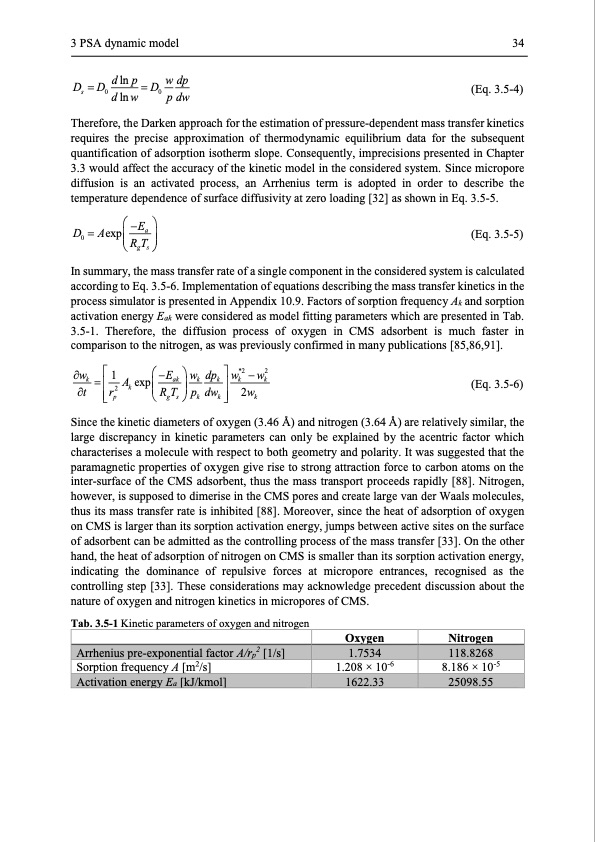
PDF Publication Title:
Text from PDF Page: 047
3 PSA dynamic model 34 D =D dlnp=D wdp (Eq.3.5-4) s 0dlnw0pdw Therefore, the Darken approach for the estimation of pressure-dependent mass transfer kinetics requires the precise approximation of thermodynamic equilibrium data for the subsequent quantification of adsorption isotherm slope. Consequently, imprecisions presented in Chapter 3.3 would affect the accuracy of the kinetic model in the considered system. Since micropore diffusion is an activated process, an Arrhenius term is adopted in order to describe the temperature dependence of surface diffusivity at zero loading [32] as shown in Eq. 3.5-5. −E D = Aexp a (Eq. 3.5-5) 0 RT gs In summary, the mass transfer rate of a single component in the considered system is calculated according to Eq. 3.5-6. Implementation of equations describing the mass transfer kinetics in the process simulator is presented in Appendix 10.9. Factors of sorption frequency Ak and sorption activation energy Eak were considered as model fitting parameters which are presented in Tab. 3.5-1. Therefore, the diffusion process of oxygen in CMS adsorbent is much faster in comparison to the nitrogen, as was previously confirmed in many publications [85,86,91]. (Eq. 3.5-6) Since the kinetic diameters of oxygen (3.46 Å) and nitrogen (3.64 Å) are relatively similar, the large discrepancy in kinetic parameters can only be explained by the acentric factor which characterises a molecule with respect to both geometry and polarity. It was suggested that the paramagnetic properties of oxygen give rise to strong attraction force to carbon atoms on the inter-surface of the CMS adsorbent, thus the mass transport proceeds rapidly [88]. Nitrogen, however, is supposed to dimerise in the CMS pores and create large van der Waals molecules, thus its mass transfer rate is inhibited [88]. Moreover, Tab. 3.5-1 Kinetic parameters of oxygen and nitrogen Oxygen Nitrogen Sorption frequency A [m2/s] 1.208 × 10-6 8.186 × 10-5 w 1 −E w dp w*2 −w2 k=Aexpakk kk k tr2k RTpdw2w p gskkk on CMS is larger than its sorption activation energy, jumps between active sites on the surface hand, the heat of adsorption of nitrogen on CMS is smaller than its sorption activation energy, since the heat of adsorption of oxygen of adsorbent can be admitted as the controlling process of the mass transfer [33]. On the other indicating the dominance of repulsive forces at micropore entrances, recognised as the controlling step [33]. These considerations may acknowledge precedent discussion about the nature of oxygen and nitrogen kinetics in micropores of CMS. Arrhenius pre-exponential factor A/rp2 [1/s] 1.7534 118.8268 Activation energy Ea [kJ/kmol] 1622.33 25098.55PDF Image | Modelling and Simulation of Twin-Bed Pressure Swing Adsorption Plants

PDF Search Title:
Modelling and Simulation of Twin-Bed Pressure Swing Adsorption PlantsOriginal File Name Searched:
dissertation_marcinek.pdfDIY PDF Search: Google It | Yahoo | Bing
CO2 Organic Rankine Cycle Experimenter Platform The supercritical CO2 phase change system is both a heat pump and organic rankine cycle which can be used for those purposes and as a supercritical extractor for advanced subcritical and supercritical extraction technology. Uses include producing nanoparticles, precious metal CO2 extraction, lithium battery recycling, and other applications... More Info
Heat Pumps CO2 ORC Heat Pump System Platform More Info
| CONTACT TEL: 608-238-6001 Email: greg@infinityturbine.com | RSS | AMP |